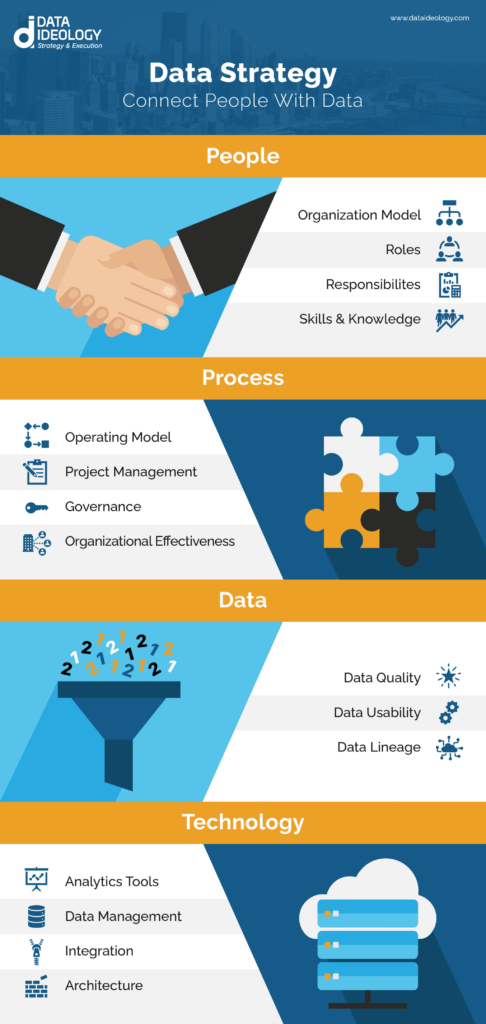Data Strategy Assessment: Current and Future State Analysis

Before you can start using data to help your business, you need to understand what data you have and how the organization is utilizing it. By taking the time to perform a data strategy assessment, you can answer critical questions about the data’s current state and its future state development.
Many businesses have large quantities of data that are unstructured and unused. A data strategy assessment allows you to recognize ways to access resources sooner while closing any gaps within your data ecosystem.
Understand your Current Data Landscape
If you don’t already have a data strategy in place, answering these questions will give data & IT leaders a better understanding of the current situation.
- What data do you already have access to?
- What sources will you need to collect data from?
- What is your organizational structure to manage data and analytics?
- What tools and technologies are currently in place?
- What data governance policies and procedures are in place?
Being aware of the current state of your data is vital for making timely and accurate business decisions today. Simply making sure assets are correct, up to date, and arranged in a way so that it’s easy to utilize can be a difference-maker.
Your data landscape may vary depending on your company’s size, sector, and other factors. However, there are a few staple elements that all organizations should record and maintain:
- Customer data: Customer names, phone numbers, addresses, purchase histories, and loyalty data.
- Marketing data: Website traffic, social media engagement, and email/SMS open and click rates.
- Sales information: Conversion rates due to contact form submissions, gated content downloads, phone calls, etc.
- Operational data: The day-to-day information your business creates, such as financial data, employee records, and inventory levels, just to name a few.
- Product data: Information about the products or services you offer, including SKUs, pricing, descriptions, and images.
After performing a data strategy assessment, you will have a clearer picture of your data landscape and will begin seeking ways to make further improvements. It would be best to consider how data is currently being used in your organization and its effort to deliver a solution to key stakeholders.
If your data is inaccurate or incomplete, you may need to budget for data cleaning and enrichment services. You may need to invest in data management and governance solutions if your data is poorly structured.
After you’ve gotten a firm grasp on your data, it’s time to start thinking about utilizing it. This might be an intimidating task, but following our data strategy process will get you started on the right foot to making improvements.
Assessment to Data Utilization
When you’ve gotten a handle on your data, it’s time to figure out what you need and where there are gaps. This will assist you in determining the data needed to meet your strategic goals and plans. You might have to gather new information or enhance data quality and accuracy.
Make sure you know what data is available and how it may be utilized to help you meet your objectives. This covers both internal and external data. Internal data is already in your company, whereas external data is information from outside sources. External data can be a helpful tool, but you must ensure you’re using sound and reliable information. Before using it in your plan, double-check its quality.
There are numerous elements to consider when determining data requirements and gaps, including:
- Business objectives
- Current data sources and data quality
- The need for new data sources
- Types of analysis required
- Timing and deadlines
- Budget and resources
You may build a data strategy suited to your company by working with senior leadership to assess your data requirements and gaps. This will help guarantee that the data you collect is put to good use by leadership and data consumers. Once you’ve assessed your data needs and gaps, it’s time to develop a plan to address them.
Develop Future State Data Strategy
We’ve discussed that a data strategy assessment will help organizations better understand their data’s current state. The assessment will also shed light on the future state development and what the organization is looking for.
At this point in the process, it’s time to figure out how you’ll get from where you are now to where you want to be. That will require thinking about the end goal for your data and a strategy for achieving it.
Some critical considerations when developing your future state data strategy are:
- What analytics do you want to be able to run?
- What data do you need to support your business goals?
- How will you use data governance to ensure the accuracy and consistency of data across the organization?
- What data management processes and tools will you need in place?
By developing a future state strategy, you can ensure that your data will support your business goals and enable you to drive results.
A data strategy is not a “one size fits all” and should be tailored to your organization’s specific needs. However, some key components are essential to any data strategy. Here is a list of things that must be included in your future state strategy.
- Business and data strategy
- Technology strategy
- Governance model
- Data management processes
- Data governance and data quality
- Business value (business case and prioritization)
- Build consensus and support
To create a data strategy that will enable you to achieve your business goals, you need to understand your current data state and your future state data strategy. You will want to ensure you consider the four key components:
- People: Ensure that everyone involved has active participation across all business units and at all levels of leadership, including individuals who are not directly responsible for the project.
- Process: A holistic view of the business processes. A change in one area may significantly impact downstream or even upstream. To understand how data is created, modified, and used, you must examine the entire process and some related functions during the assessment. In addition, it is essential to understand how data flows within the process and out of it. This means including stakeholders in brainstorming exercises and in-process review sessions.
- Technology: Evaluations should include both existing and new technology. Using new technologies does not always mean they are better. Sometimes existing solutions can be modified or enhanced to deliver the solution. Consider all options, not just the current hot technology, if the technology represents a leap forward.
- Data: Examine ALL data. Understanding how and why each data consumer uses each type of data is essential. All your internal and external data, master data, operational data, and metadata are included here.

Unlock your data with a Data Strategy Assessment
To understand your current data state and its future development, you need to analyze your data architecture, governance, quality, and management processes through a data strategy assessment. This exercise will give you a good understanding of the current state of your data and the challenges you need to address.
Once you understand your current data state, it is time to develop a future state data strategy. This will involve envisioning the end goal for your data and creating a plan to get there.
Developing a data strategy can be a daunting task, and while the tips we have shared here can help make the process easier, it can still be challenging to account for all the pieces of the data strategy puzzle.

